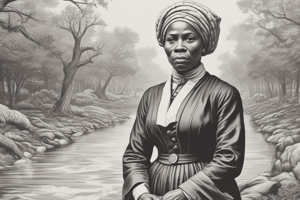Podcast
Questions and Answers
What was one of Harriet Tubman's nicknames?
What was one of Harriet Tubman's nicknames?
- The Emancipator
- The Rescuer
- Moses (correct)
- The Pioneer
What was a significant consequence of the Fugitive Slave Act of 1850?
What was a significant consequence of the Fugitive Slave Act of 1850?
- It led to the establishment of more safe houses across the South.
- It allowed enslaved people to remain safe in the Northern states.
- It initiated a series of formal routes for the Underground Railroad.
- It forced the Underground Railroad to extend into Canada. (correct)
What roles did Tubman play during the Civil War?
What roles did Tubman play during the Civil War?
- Scout and spy (correct)
- Nurse and educator
- General and strategist
- Logistics coordinator and medic
How many people is Harriet Tubman believed to have aided in escaping slavery?
How many people is Harriet Tubman believed to have aided in escaping slavery?
What kind of network was the Underground Railroad primarily known as?
What kind of network was the Underground Railroad primarily known as?
Flashcards
The Underground Railroad
The Underground Railroad
A network of secret routes and safe houses used by enslaved people to escape to freedom in the North or Canada.
Station Masters
Station Masters
People who provided shelter and guidance to enslaved people escaping on the Underground Railroad.
Conductors
Conductors
People who guided enslaved people along the Underground Railroad routes.
Harriet Tubman
Harriet Tubman
Signup and view all the flashcards
Escaping Slavery
Escaping Slavery
Signup and view all the flashcards
Study Notes
Harriet Tubman and the Underground Railroad
- Harriet Tubman was born into slavery in Maryland and experienced severe abuse.
- In 1849, she escaped to Philadelphia and returned repeatedly to rescue her family, friends, and other enslaved individuals.
- The Underground Railroad wasn't a formal organization but a network of secret safe houses ("stations") and routes.
- Enslaved people used these routes to escape to free states and Canada.
- Most station masters didn't know each other to maintain secrecy.
- "Conductors" aided travelers along the routes.
- Nearly 1,000 people annually escaped via the Underground Railroad.
Tubman's Contributions
- Nicknamed "Moses," Tubman helped approximately 70 people escape slavery, without losing any.
- She aided John Brown in recruiting for his raid on Harper's Ferry.
- Tubman served as a spy and scout during the Civil War, focusing on freeing enslaved people.
- She spoke extensively on the abolition circuit, sharing her experiences.
- After the Civil War, she actively participated in the women's suffrage movement.
Fugitive Slave Act's Impact
- The 1850 Fugitive Slave Act forced the Underground Railroad to extend its routes to Canada (then British North America) to protect escaped enslaved people.
- The Fugitive Slave Act required Northerners to return escaped slaves to their owners.
Studying That Suits You
Use AI to generate personalized quizzes and flashcards to suit your learning preferences.
Description
Explore the life and contributions of Harriet Tubman, a key figure in the Underground Railroad. This quiz delves into Tubman's journey from slavery to freedom, her role in aiding others, and her legacy in the fight against slavery. Discover how her actions shaped history and helped many escape to freedom.




